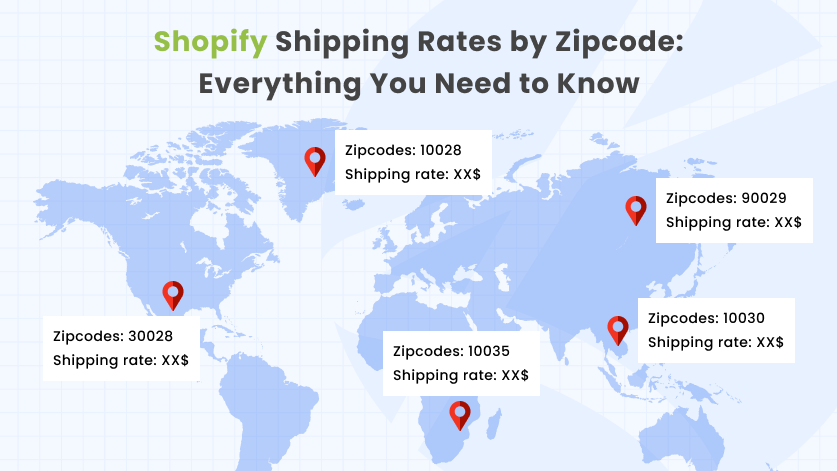When it comes to running a successful eCommerce business, one critical aspect is often overlooked – shipping rates by zip code. Shopify, one of the most popular eCommerce platforms, offers a versatile and powerful shipping feature that allows you to tailor your shipping rates according to different zip codes.
The purpose of this guide is to show why shipping rates by zip code are crucial and how to figure them out correctly.
We’ll also talk about how you can easily add shipping rates to your Shopify store. Achieving mastery over zip code-based shipping rates is important for staying competitive and making sure customers are happy, no matter how experienced you are with eCommerce.
Let’s begin this journey together and understand why shipping rates by zip code are crucial for Shopify owners.
What are Shipping Rates by Zip Code?
Shipping rates by zip code are the shipping costs associated with shipping products to specific geographic areas. They are typically determined by a number of factors, including the distance between the origin and destination, the weight and size of the package, and the shipping carrier.
A key feature of shipping rates by zip code is the ability to create custom shipping rates for different geographical areas. This level of customization is especially useful because shipping costs can vary significantly depending on the distance between the seller’s location and the customer’s delivery address.
Many eCommerce platforms, including Shopify, offer zone-based systems where Shopify owners can group multiple zip codes into a single zone. This simplifies the process of setting and managing shipping rates for a wider region.
Shipping rates by zip code also allow Shopify owners to offer promotions and incentives to customers in specific areas.
For example, a business might offer free shipping to a certain zip code to reward loyal customers for their patronage. This can increase customer loyalty and attract more business from the region.
As you know market conditions change every few months, such as carrier rates or seasonal demand fluctuations, Shopify owners can easily adapt their shipping rates for different zip codes. This adaptability is crucial to remaining competitive in the eCommerce industry.
This approach allows Shopify owners to adapt to changing market conditions and align their shipping rates accurately with the expenses incurred for delivery to specific locations, making it an essential component of a successful eCommerce operation.
Why are Shipping Rates by Zip Code Important?
Shipping rates by zip code play a pivotal role in the success of eCommerce businesses and are essential for several reasons:
1. Accurate Pricing: Shipping rates by zip code allow Shopify owners to charge customers accurately for specific delivery locations. This accuracy is crucial because shipping rates can vary significantly depending on the distance and logistics involved. Customers appreciate knowing that they are being charged fairly for shipping, which improves their shopping experience.
2. Customer Satisfaction: When customers feel that they are being charged fairly for shipping, it contributes to overall customer satisfaction. Happy customers are more likely to return for future purchases and recommend the eCommerce business to others. This can lead to increased customer loyalty and improved long-term success.
3. Competitive Advantage: eCommerce is a highly competitive industry, and offering competitive shipping rates can give a business a significant advantage. When customers compare shipping costs and find that a particular business offers fair and transparent rates, they are more likely to choose that business over competitors with less flexible shipping pricing.
4. Local Promotions: Shipping rates by zip code enable businesses to run targeted local promotions. For example, a business can offer free or discounted shipping to customers in specific zip codes as a way to incentivize purchases from that region. These promotions can be a powerful marketing tool to boost sales and attract new customers.
5. Zone-Based Efficiency: Grouping zip codes into zones using this system simplifies rate management for businesses. Instead of setting individual rates for every zip code, they can create uniform rates for entire zones, streamlining the process. This level of efficiency is essential for managing shipping costs effectively.
6. Adaptability: Market conditions can change, affecting shipping costs. By having the ability to adjust rates by zip code, businesses can adapt to these changes quickly. Whether it’s fluctuating carrier rates, fuel costs, or changes in demand, businesses can make necessary adjustments to maintain profitability and competitiveness.
7. Data-Driven Decision Making: eCommerce platforms often provide businesses with data on the impact of their rate changes. This data can be analyzed to make informed decisions about shipping strategies. By understanding how rate changes affect sales and profitability, businesses can optimize their shipping rate effectively.
8. Transparency: Transparent and fair pricing is essential for building trust with customers. When customers see that a business charges shipping rates that align with the actual costs of shipping, it builds trust. Trust is a critical factor in the eCommerce industry, as it encourages customers to complete transactions with confidence.
How to Calculate Shipping Rates by Zip Code?
It takes a data-driven method to calculate shipping rates by zip code. Factors including transportation distance, carrier costs, and regional demand must be considered by businesses.
Here is a straightforward example:
Assume you manage a shop and sell goods. According to your data, shipping to a zip code within 50 miles costs $10, while shipping to a zip code from 50 to 150 miles costs $15. On the other hand, shipping to a zip code more than 150 miles costs $20. Your system may set these rates to guarantee clear cost estimations.
The system will now calculate the shipping rates when consumers enter their zip code during the checkout process by taking into account the distance between your location and their location. Customers will get accurate cost information in this method.
How to Set Up Shipping Rates by Zipcode for Your eCommerce Store?
On Shopify, you may directly configure zip code-based shipping charges from the admin panel, although there may be certain limitations. Shopify Plus provides cutting-edge functionality for businesses that deal in large volumes.
Instead, think about researching third-party solutions designed to expedite this process. Your customers will pay shipping costs that are accurate and transparent if you use programs like ShipZip – Shipping and Delivery, which make it simple to monitor and apply shipping rates by zip code. To fit your specific needs, these apps typically provide extra functionality and customization options.
Benefits of Using Shipping Rates by Zip Code:
It’s very important to use shipping rates by zip codes when doing business online if you want to be successful. Adding this feature to your store can really change your business, and we’ll show you how by giving you some real-life cases and figures.
1. Increase Customer Satisfaction:
You may prevent your consumers from being surprised by additional fees at the checkout by giving precise shipping rates by zip code. Studies have revealed that 25% of buyers remove items from their shopping carts because of shipping costs, therefore this is quite important. You might greatly raise consumer satisfaction by attending to this issue. Promote repurchasing.
2. Reduced Shipping Costs:
You may efficiently fine-tune your shipping strategy when you use zipcode-based shipping rates. You may find low-cost shipping routes and carriers that are targeted to zip codes by using data analysis and insights. This clever strategy may enable you to reduce your delivery costs.
3. Improved Efficiency:
Your fulfillment process will go more smoothly if you calculate shipping rates by zip code with accuracy. By intelligently selecting warehouse sites and optimizing inventory arrangement, you may cut down on delivery distances, which cuts down on delivery time and costs. Zip code-based delivery is one of the reasons for Amazon’s extraordinary performance in making deliveries.
4. Improve Customer Retention:
Improving customer retention is a critical goal for every Shopify store owner. When Shopify owner communicates the benefits of customized shipping rates to customers, it can enhance their perception of the brand.
Transparent communication about how these rates work and how they benefit the customer can contribute to improved customer retention.
These factors collectively create an environment where customers are more likely to stay engaged with the brand and make repeat purchases, ultimately improving customer retention rates.
5. Increase Sales:
Making shipping rates based on zip codes visible encourages customers to complete their orders. According to ReadyCloud research, clearly showing shipping charges and expected delivery dates may boost conversions by as much as 77%.
6. Reduce Cart Abandonment Rate:
Customers who discover unexpected shipping costs are more likely to leave their shopping carts empty. You can significantly reduce cart abandonment rates and increase the number of transactions that are successful by displaying zipcode rates during the shopping process.
7. Improve Customer Loyalty:
Increase customer loyalty by offering consistently accurate shipping rates by zip code. For an eCommerce enterprise, revenue is often generated by repeat customers. They are likely to recommend others, starting a virtuous circle of growth.
How to Use Shipping Rates by Zip Code to Improve Your Customer Experience?
Strategic zipcode-based shipping prices may enhance your customers’ overall experience, giving you a competitive edge in today’s market. Here, supported by relevant statistics and real-world examples, we’ll look into the crucial strategies to do this.
- Free Shipping to Specific Zip Codes: First, think about providing free delivery to certain zip codes in order to increase business and client loyalty in the desired areas. By offering free two-day shipping to qualified zip codes, Amazon Prime, as one prominent example, has established a precedent and attracted millions of devoted Prime members.
- Discounted Shipping to Specific Zipcodes: The second way to drastically boost sales in a certain area is to offer cheap delivery to a certain zip code. According to a case study, this method resulted in a noticeably higher order volume in certain areas.
- Clear and Accurate Shipping Estimates: Provide clear and accurate shipping rates by zipcodes since transparency is essential for the online purchasing experience. According to a poll, 87% of customers said that delivery time affects their decision to buy anything online.
- Offer Flexible Delivery Options: Consider providing several delivery choices, such as same-day, next-day, or normal delivery, to consumers in particular zipcodes to accommodate diverse client preferences. One excellent example of this tactic in action is Walmart’s zip-based shipping alternatives.
- Shipping Rates for Multiple Items: Customers are guaranteed to obtain fair and competitive prices by basing shipping charges for multiple goods on the number and weight of items in the basket as well as the destination zip code. These variables drive eBay’s dynamic shipping pricing adjustments, which promote larger orders.
Learn more about how to optimize Shopify shipping rates for multiple items.
- Custom Shipping Rates: Finally, take into account providing Custom Shipping Rates designed to meet the specific demands of your company. Custom pricing for certain zip codes might help you maximize profitability and maintain competitiveness in various marketplaces.
You may address the various demands of your consumers and acquire a competitive edge in the congested eCommerce market by fine-tuning your shipping rates by zip code approach.
It’s an effective method to increase revenue, draw in new clients, and cultivate a foundation of devoted clients. It has never been more promising to use strategic shipping to improve customer experience.
Tips for Setting Up Shipping Rates by Zipcode:
Now let’s delve into each of the tips for setting up shipping rates by zip code with detailed explanations and examples:
1. Consider Your Business Goals:
Before you start implementing shipping rates by zipcodes it’s important to have an understanding of your business goals.
For example, if you’re looking to expand your customer base in an area you might consider offering discounted or free shipping to customers in that region.
On the other hand if your focus is, on maximizing profit margins you may need to adjust the rates to cover the costs associated with shipping.
Let’s say you operate a clothing store and want to increase sales, on the East Coast of the United States. To achieve this objective you decide to provide shipping for customers residing in zip codes located on the East Coast. This approach aligns with your goal of boosting sales in that area.
2. Segment Your Customers:
Shipping rates based on zip codes are decided in part by customer segmentation. You may identify consumer groups by looking at variables like geography, buying history, and preferences. As a result, you may adjust your delivery costs to accommodate various groups.
Take your subscription box business, for instance. You’ve noticed that clients who live in certain locations tend to subscribe for set periods of time.
You provide clients with zip codes and lower shipping prices in order to promote this behavior. Customers in populous regions, however, would pay ordinary delivery costs.
3. Test and Optimize Your Shipping Rates:
Calculating shipping costs is a process, not a one-time activity. In order to find the best rate structures and methods, it is crucial to experiment and assess several options. Pay attention to consumer reviews. Keep track of sales data so you can make wise adjustments.
Imagine, for example, that you run an electronics shop. For all first orders, you charge a set delivery price. However, after looking at customer reviews and order histories, you realize that people who buy things are put off by this price.
You make the decision to implement a shipping price system dependent on the number of products in each customer’s basket in order to maximize your rates. Increased order values and customer satisfaction result from this modification.
Overall, it is critical to approach setting up shipping rates by zip code while taking your company objectives, shipping costs, client segmentation, and ongoing testing and rate optimization into account.
You cannot accomplish your company objectives by adhering to these recommendations and changing your plan as necessary. Additionally, make your consumers’ whole experience better.
Conclusion:
In conclusion, understanding Shopify shipping rates by zip code is a fundamental aspect of running a successful eCommerce business for Shopify store owners. By tailoring your shipping rates to specific geographic areas, you can provide accurate pricing, increase customer satisfaction, and gain a competitive advantage in the dynamic world of online retail.
Shipping rates by zip code offer benefits, including the ability to offer targeted local promotions, streamline efficiency through zip code zone-based systems, and adapt to changing market conditions. They also facilitate data-driven decision-making and promote transparency in pricing, which builds trust with customers.
Calculating shipping rates based on zip codes is a data-driven process that considers various factors, such as transportation distance, carrier costs, and regional demand. While Shopify provides options for setting up zip code-based shipping rates, using a third-party app called “ShipZip – Shipping and Delivery” this app offers functionality and customization to your shipping rate and delivery date.
The advantages of using shipping rates by zip code are numerous, from improving customer satisfaction to reducing shipping rates and improving customer retention. These pricing strategies can also increase sales and reduce cart abandonment rates, ultimately leading to increased customer loyalty.
By offering free or discounted shipping, clear and accurate shipping estimates, flexible delivery options, and custom shipping rates, businesses can tailor their approach to specific customer segments and achieve their unique business goals. Continuous testing and optimization are essential to finding the most effective rate structures and methods for your eCommerce store.
If you have any further questions, leave them in the comments, and we will get to you asap.








